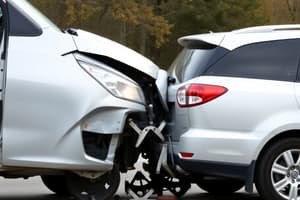Podcast
Questions and Answers
What characterizes a head-on collision?
What characterizes a head-on collision?
- Momentum is not conserved.
- Colliding bodies move at different angles.
- Kinetic energy is always conserved.
- Velocities are confined to the same straight line. (correct)
Which statement is true about elastic collisions?
Which statement is true about elastic collisions?
- Both momentum and kinetic energy are conserved. (correct)
- Forces involved are always non-conservative.
- They are always perfectly inelastic.
- They result in maximum kinetic energy loss.
What happens during a perfectly inelastic collision?
What happens during a perfectly inelastic collision?
- Momentum is not conserved.
- Kinetic energy is conserved.
- The bodies stick together after collision. (correct)
- The colliding bodies bounce off each other.
In which type of collision is kinetic energy not conserved?
In which type of collision is kinetic energy not conserved?
How are oblique collisions different from head-on collisions?
How are oblique collisions different from head-on collisions?
What describes the line of impact during a collision?
What describes the line of impact during a collision?
In what situation is momentum conserved but kinetic energy is not?
In what situation is momentum conserved but kinetic energy is not?
Which scenario exemplifies an oblique collision?
Which scenario exemplifies an oblique collision?
Flashcards are hidden until you start studying
Study Notes
Collisions
- Interactions between bodies that involve an exchange of momentum within a short period.
- Bodies may come into contact or not, for example, a particle scattering off a nucleus due to repulsion.
Types of Collisions by Motion
- Head-on/One-dimensional Collision: Bodies' velocities are confined to the same straight line before and after.
- Oblique Collision: Velocities are not confined to the same line, can be two or three-dimensional.
Types of Collisions by Energy Conservation
- Elastic Collision: Momentum and kinetic energy are conserved. Forces are conservative. Examples include atomic particle collisions.
- Inelastic Collision: Momentum is conserved, but not kinetic energy. Forces are non-conservative. Example: collisions between vehicles.
- Perfectly Inelastic Collision: Colliding bodies stick together after collision, moving as a single unit. Maximum kinetic energy loss. Example: bullet embedded in a block.
Line of Impact
- The line passing through the common normal to the surfaces in contact during impact.
- The collision force acts along this line on both bodies.
- Example: balls A and B approaching along line CD, the line CD is the line of impact.
Studying That Suits You
Use AI to generate personalized quizzes and flashcards to suit your learning preferences.



